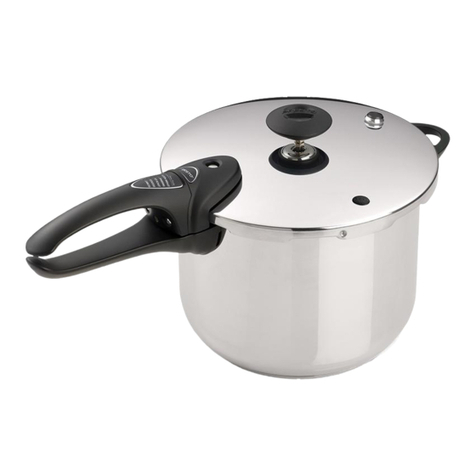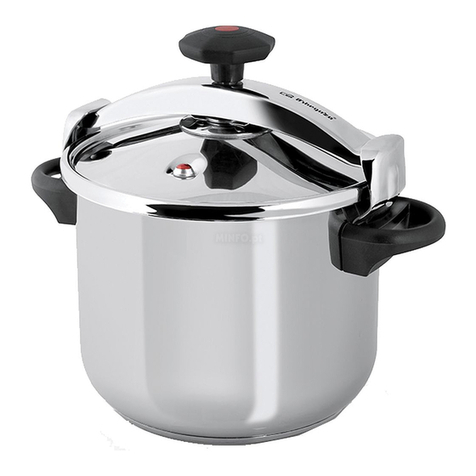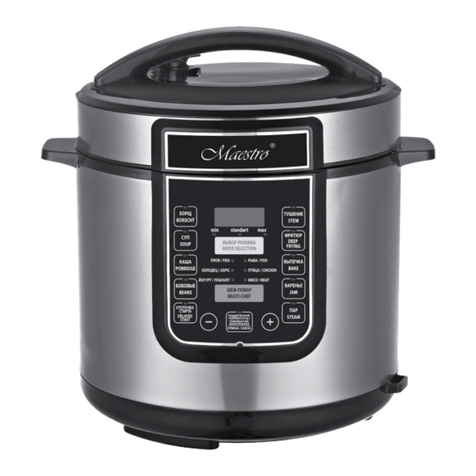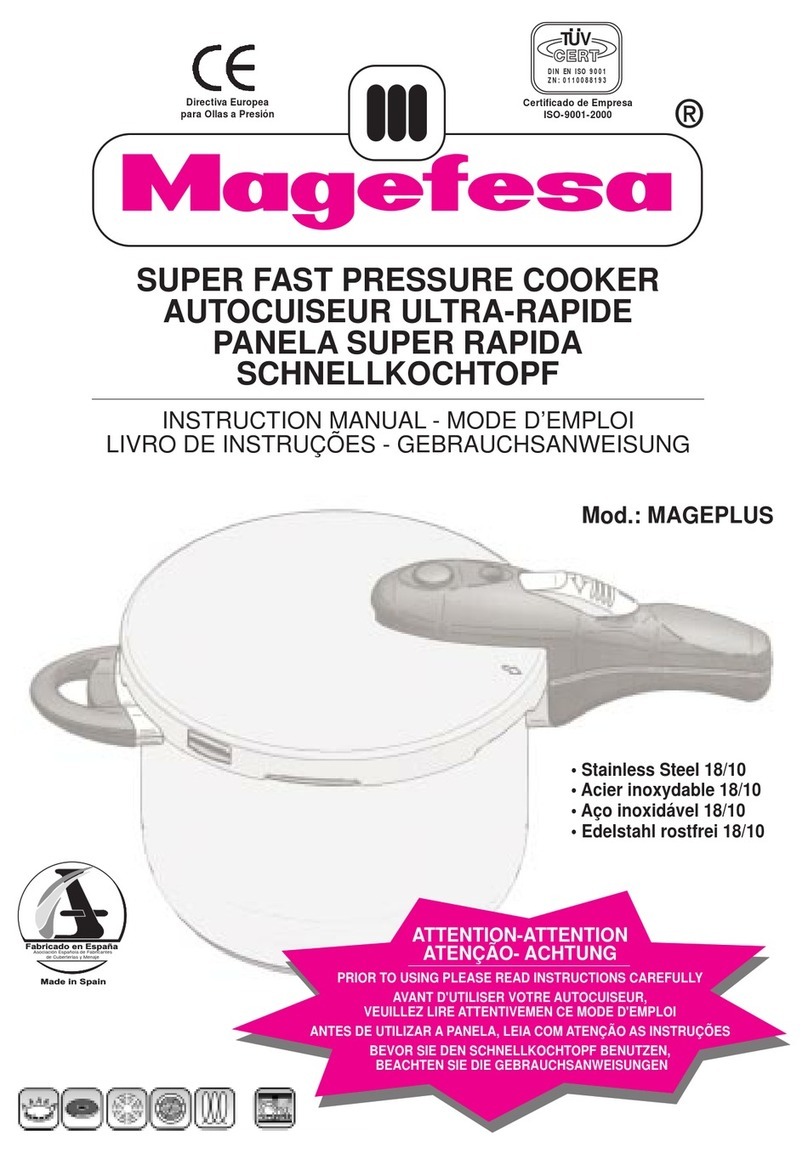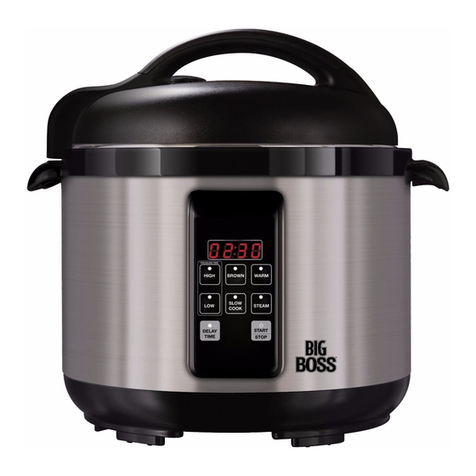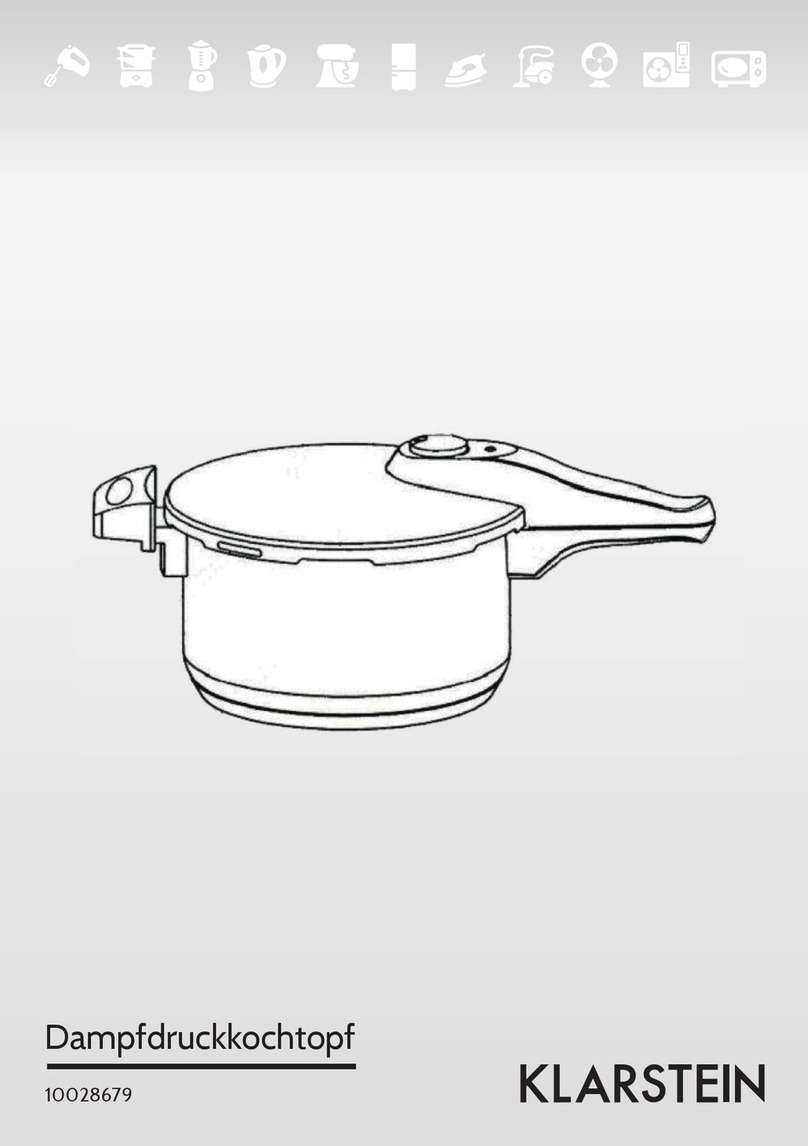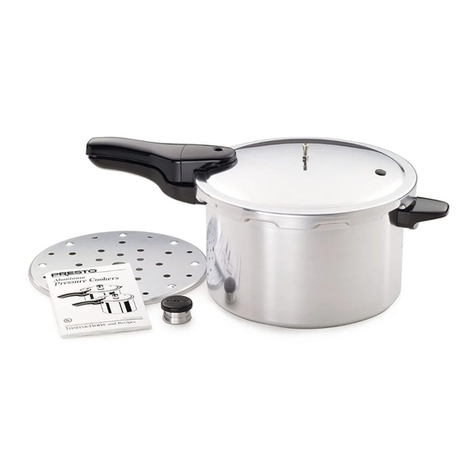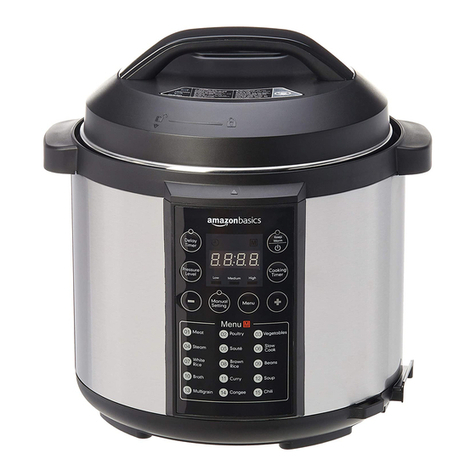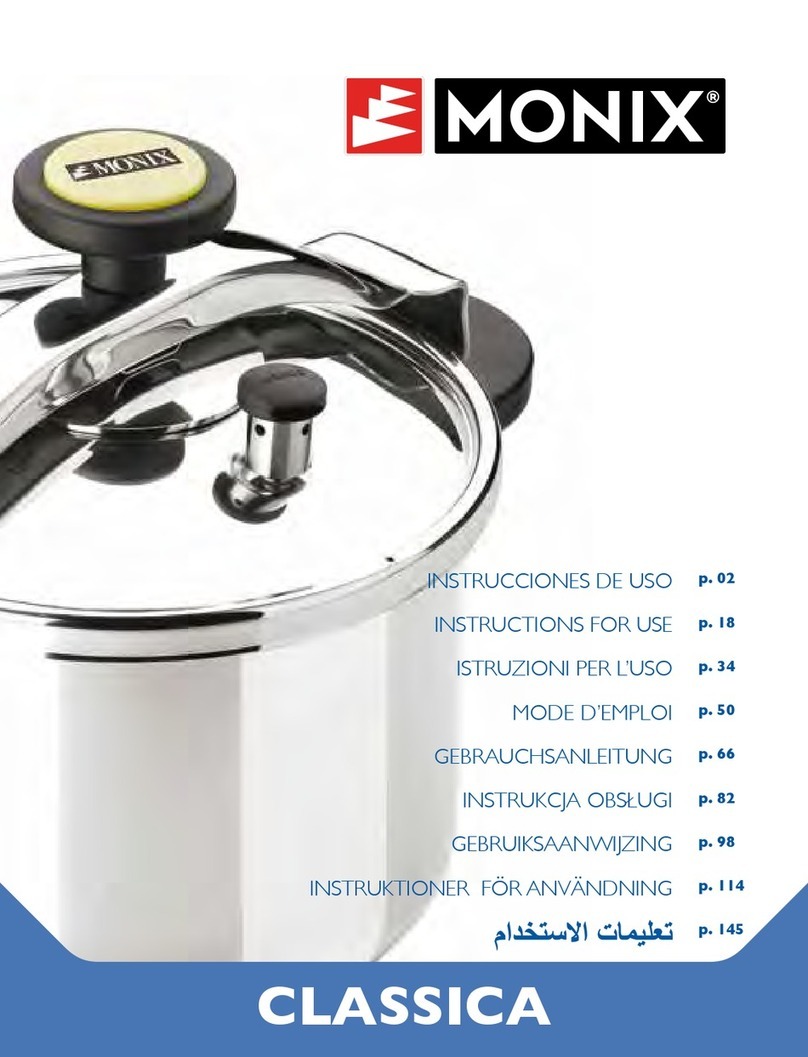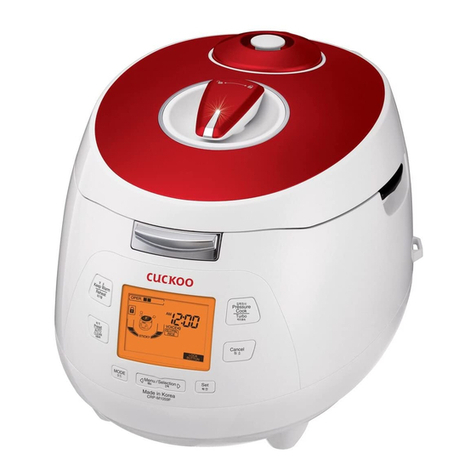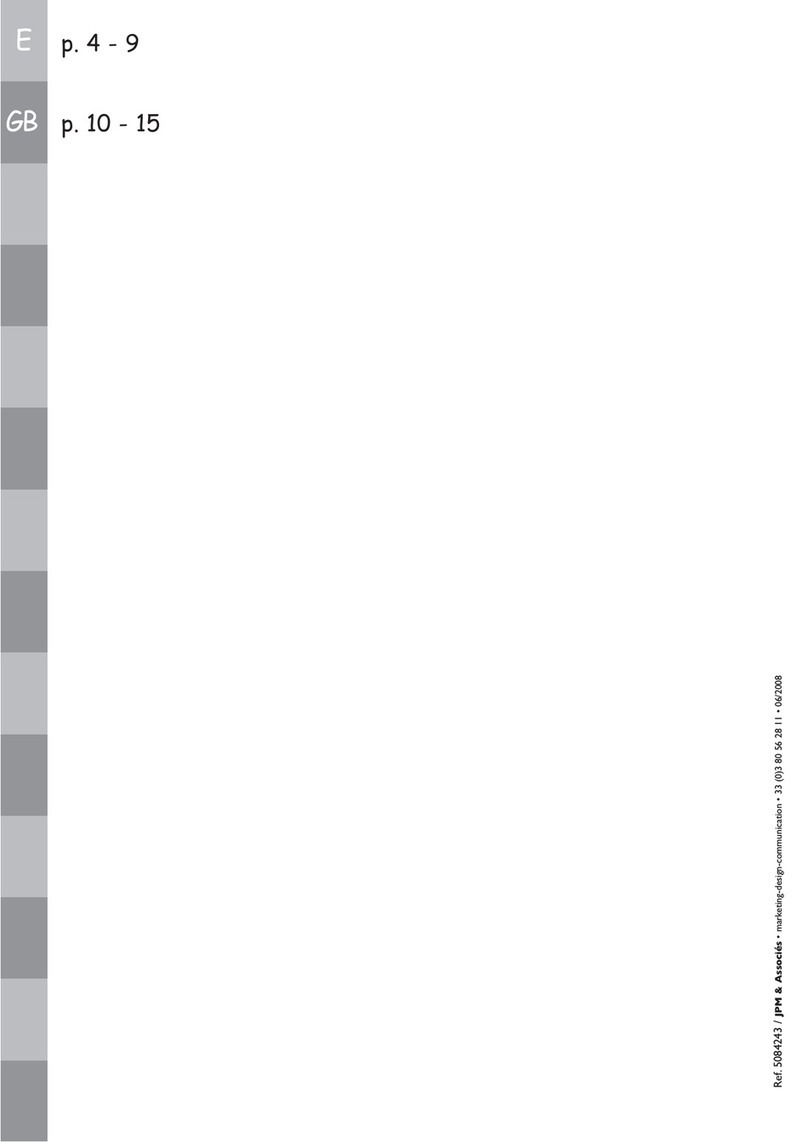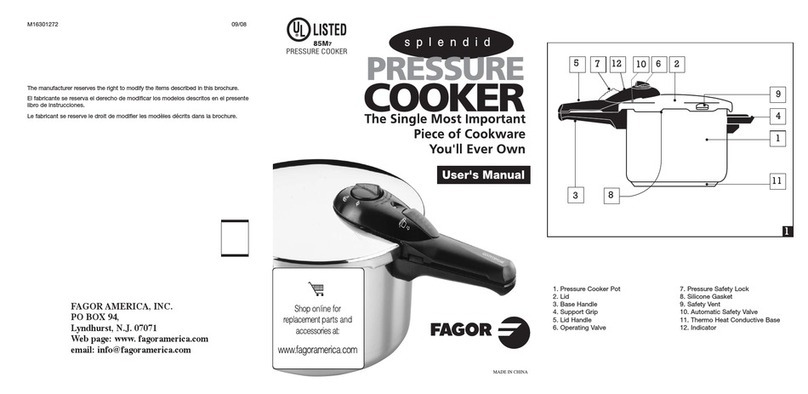Shaq Y8D-36 User manual

Save These Instructions – For Household Use Only
Owner’s Manual
MODEL: Y8D-36 (8 qt.)
When using electrical appliances, basic safety precautions should
always be followed. Do not use the ShaqPot Pressure Cooker
until you have read this manual thoroughly.
Visit TristarCares.com for tutorial
videos, product details, and more.
Guarantee Information Inside

2ShaqPot Pressure Cooker ShaqPot Pressure Cooker 3
IMPORTANT SAFEGUARDS 4
Attaching the Power Cord 5
Features & Benefits 6
A. Built-In Safety Devices 6
1. Lid Safety Device
2. Spring-Loaded Safety Devices
3. Back-Up Safety Release Valve
4. Clog-Resistant Feature
5. Pressure & Temperature Sensors
6. Temperature Cut-Off Device
7. Magnetic Sensor for Lid
B. Special Features 7
1. Digital Display
2. Warm Mode
3. Sterile Environment
4. Red Pressure Indicator
5. Pressure Release Valve
6. One-Touch Technology
Releasing Pressure 8
Natural Release and Rapid Release 8
· How Natural Release Works
and When to Use It
· How Rapid Release Works
and When to Use It
BEFORE YOU BEGIN
The ShaqPot will provide you many years of
delicious family meals and memories around
the dinner table. But before you begin, it’s very
important that you read this entire manual, making
certain that you are totally familiar with this
appliance’s operation and precautions.
ShaqPot Pressure Cooker Table of Contents
Parts & Accessories 10
Assembly Instructions 12
Instructions for Use 14
A. Preparing for Use 14
· Check Parts & Accessories
· Conduct Test Run with Water Only
B. Operation Instructions 16
Pressure Cooking Programs 18
Sous Vide 20
Yogurt 22
General Pressure Cooking
Time Charts 23
Frequently Asked Questions 24
Care & Cleaning 25
Troubleshooting 26
Canning Guide 28
Manufacturer’s 60-Day Guarantee 33

4ShaqPot Pressure Cooker ShaqPot Pressure Cooker 5
SAVE THESE INSTRUCTIONS – FOR HOUSEHOLD USE ONLY
1. Read all instructions carefully to prevent injuries.
2. This appliance is not intended for use by persons with
reduced physical, sensory, or mental capabilities or
a lack of experience and knowledge unless they are
under the supervision of a responsible person or have
been given proper instruction in using the appliance.
Do not leave unattended with children or pets. Keep
appliance and cord away from children. Anyone who
has not fully read and understood all operating and
safety instructions contained in this manual is not
qualied to operate or clean this appliance.
3. Always place appliance on a at, heat resistant
surface. Intended for countertop use only. DO NOT
operate on unstable surface. DO NOT place on or
near a hot gas or electric burner or in a heated oven.
DO NOT operate the appliance in an enclosed
space or under hanging cabinets. Proper space and
ventilation is needed to prevent property damage that
may be caused by steam released during operation.
Never operate the appliance near any ammable
materials, such as dish towels, paper towels, curtains,
or paper plates. Do not let the cord hang over the
edge of the table or counter or touch hot surfaces.
4. NEVER FORCE THE LID OPEN. Never attempt
to open Lid during operation as a pressure cooker.
Any pressure in the cooker can be hazardous. Do not
open the pressure cooker until appliance has cooled
and all internal pressure has been released. If the lid is
difcult to open, this indicates that the appliance is still
under pressure - do not force it open. Once pressure
is released, follow instructions to open Lid. Always
open Lid away from face and body to avoid steam
burns (see OPERATING INSTRUCTIONS, p.16).
5. Lid should rotate freely and any resistance
indicates that the Lid is improperly placed
or under pressure.
6. DO NOT place the appliance on stove top surfaces,
including gas, glass, and electric stove tops.
IMPORTANT SAFEGUARDS IMPORTANT SAFEGUARDS
7. Always attach plug to appliance rst, then plug cord
into the wall outlet. To disconnect, turn any control
to “off,” then remove plug from wall outlet.
8. This appliance cooks under pressure. Improper use
may result in scalding injury. Make certain appliance
is properly closed before operating and the Pressure
Release Valve is free from debris.
9. Extreme caution must be used when moving an
appliance containing hot oil or other hot liquids.
RECOMMENDED: DO NOT LIFT OR MOVE THE
APPLIANCE when under pressure or when contents
are hot. Hot spilled foods can cause serious burns!
To remove contents in cooker, use ladle provided.
10. Always check the pressure release devices
for clogging before use.
11. CAUTION HOT SURFACES: This appliance
generates extreme heat and steam during use.
Do not touch hot surface. Use handles or knobs.
To avoid injury, do not touch the hot surfaces or the
Pressure Release Valve on the Lid during operation.
Proper precautions must be taken to prevent the risk
of personal injury, res, and damage to property.
12. Do not use this appliance for anything other than
its intended use.
13. Hot contents may still boil after releasing steam.
Use caution while opening lid.
14. Never use the Lid Handle to lift or move cooker.
Use only the black handles located on the side of the
appliance’s base when lifting or moving the appliance
(see OPEN LID in PREPARING FOR USE, p. 14).
15. Never ll above the Inner Pot’s max ll line (FULL
CUP). Overlling can clog the Pressure Release
Valve, which can cause excess pressure to develop.
16. WARNING: to reduce risk of electric shock, cook
only in the removable container (Inner Pot) provided.
17. Some foods, such as rice, beans, applesauce,
cranberries, pearl barley, oatmeal or other cereals,
split peas, noodles, macaroni, rhubarb, and
spaghetti, expand and create foam when cooking
and need special cooking instructions. Pay particular
attention to liquid quantities. Do not ll the Inner Pot
more than HALFWAY when cooking with these foods.
WARNING
When using electrical appliances, always follow
these basic safety precautions.
PREVENT INJURIES! – CAREFULLY READ
ALL INSTRUCTIONS BEFORE USE!
18. DO NOT ll the appliance over maximum ll line
at /full. When cooking foods that expand during
cooking, such as rice or dried vegetables, do not
ll the appliance beyond the recommended level
at ½ full. Overlling may cause a risk of clogging
the Pressure Release Valve and developing excess
pressure.
19. Never deep fry or ll with oil. Do not use this pressure
cooker for pressure frying with oil.
20. The use of accessory attachments not recommended
by the appliance manufacturer may cause injuries.
21. Never use outlet below counter.
22. Never use with an extension cord.
23. Do not use appliance outdoors.
24. Do not operate if the cord or plug are damaged.
If appliance begins to malfunction during use,
immediately unplug cord from power source. DO NOT
USE OR ATTEMPT TO REPAIR A MALFUNCTIONING
APPLIANCE. Contact Customer Service for assistance
(see the back of the manual for contact information).
25. To prevent risk of explosion and injury, replace
only the Rubber Gaskets (dynamic seal ring)
as recommended by the manufacturer.
26. Unplug the appliance from the outlet when not in
use and before cleaning. Allow the appliance to cool
before attaching or removing parts.
27. NEVER IMMERSE HOUSING IN WATER. IF
APPLIANCE FALLS OR ACCIDENTALLY BECOMES
IMMERSED IN WATER, UNPLUG FROM WALL
OUTLET IMMEDIATELY. DO NOT REACH INTO
LIQUID IF APPLIANCE IS PLUGGED IN AND
IMMERSED. DO NOT IMMERSE OR RINSE CORDS
OR PLUGS IN WATER OR OTHER LIQUIDS.
28. Before using your new ShaqPot on any countertop
surface or other fragile surface, such as a glass
tabletop, check with your countertop manufacturer or
installer for recommendations about using appliances
on your surfaces. Some manufacturers and
installers may recommend protecting your surface
by placing a hot pad or trivet under the appliance
for heat protection. Your manufacturer or installer
may recommend that hot pans, pots, or electrical
appliances should not be used directly on top of the
countertop. If you are unsure, place a trivet or hot
pad under the appliance before using it.
• Always attach electrical cord to the appliance before
plugging the appliance into an outlet. Plug into a 3-prong
wall outlet with no other appliances on the same outlet.
Plugging other appliances into the outlet will cause the
circuit to overload.
• DO NOT USE AN EXTENSION CORD WITH THIS PRODUCT.
• This appliance has been designed for use with a 3-prong,
grounded, 120V dedicated electrical outlet only. DO NOT USE
WITH ANY OTHER ELECTRICAL OUTLET or modify the plug.
• A short power-supply cord, equipped with grounding
conductor and plug, is provided to reduce the risk
of becoming entangled or tripping over a longer cord.
• To disconnect, turn any control to “off,” then remove
plug from wall outlet.
CAUTION: Attaching the Power Cord
This product can expose you to Bisphenol A, which is known
to the State of California to cause cancer and/or birth defects
or other reproductive harm. For more information, go to
www. P65Warnings.ca.gov.
For California Residents
WARNING

6ShaqPot Pressure Cooker ShaqPot Pressure Cooker 7
1. SAFETY LID LOCK: The Lid tabs connect
under the Base tabs to lock the Lid to the Base
when fully closed.
2. POSITIVE PRESSURE MECHANISM (FLOAT
VALVE): When the pressure reaches a required
point, the pressure lifts the Float Valve up,
contacting the Locking Pin.
3. LID POSITIONING SENSOR: A magnetic
sensor indicates whether the Lid is fully closed.
The appliance will beep and display “LID” when
the Lid is not locked or is not required for
a preprogrammed setting.
NOTE: The Sous Vide, Steam, Sauté, Slow
Cook, and Yogurt presets will not start if the Lid
is locked. It is recommended to use the Glass
Lid to prevent splatter and keep a consistent
temperature during the Sous Vide, Steam,
Slow Cook, and Yogurt cooking cycles. It is also
recommended to have the Glass Lid on while
slow cooking to prevent splatter.
4. LID INNER TRAY (GUARD): The Inner Lid
prevents food from entering the Upper Lid
and entering the Float Valve and Pressure
Release Chambers.
5. ANTI-BLOCKAGE GUARD: Guards the
underside of the Pressure Release Valve.
6. TWO-STEP SECURITY RESET FOR QUICK
RELEASE: The Steam Release Switch needs
to be slid once to release the steam and then
released to open the Lid. If there is steam/
pressure coming out of the Pressure Release
Valve or your hand is still holding the Steam
Release Switch in the Open position, the Lid will
not slide to open.
7. EXCESS PRESSURE RELEASE SYSTEM:
The Pressure Release Valve is weighted, which
maintains a pressure level and only allows the
appliance to build pressure at a certain level.
When the pressure is higher than the weight can
handle, the steam is released until the pressure
is less than the weight.
8. AUTOMATIC TEMPERATURE CONTROL:
The temperature is regulated by the programming
to maintain a consistent temperature.
9. PRESSURE CONTROLLER: The Inner Pot sits
on a pressure plate. When there is too much
pressure, the plate depresses and turns off the
heater, which stops the pressure from increasing.
10. ELECTRICAL (CURRENT-TEMP)
PROTECTION: There is a temperature sensor
on the Base of the appliance. When the
temperature rises above the preprogrammed
setting, the heater shuts down and then
uctuates to allow the appliance to maintain the
correct temperature.
11. CYCLE INDICATOR (LCD DISPLAY):
The LCD display changes colors and a program
countdown is shown.
12. ANTI-TAMPER FLOAT VALVE GUARD:
A screen on the Lid covers the Float Valve,
so it cannot be tampered with.
A. BUILT-IN SAFETY DEVICES
Features & Benets
1. LCD DISPLAY: The LCD Display on
your appliance offers a wide range of
37preprogrammed choices. Cooking time
may be adjusted to suit any recipe or personal
preference or delayed to meet required
timetable. The display changes color based on
its operation.
2. KEEP WARM MODE: At completion of cooking
cycle, the appliance will automatically shift to
Keep Warm mode. Keep Warm mode keeps
cooked food warm for up to 24 hrs.
NOTE: Foods kept at Keep Warm mode
for longer than 6–8 hrs. may lose their avor
and texture and can be a food safety concern
when left on the Keep Warm function too long.
3. STEAM RELEASE SWITCH: Quickly lowers
pressure. Move the Release Switch on the
top of the Lid from the Closed to the Open
position to open the Pressure Release Valve.
WARNING: Hot steam is released from the
Pressure Release Valve. DO NOT USE BARE
HANDS to open Pressure Release Valve.
4. ONE-TOUCH TECHNOLOGY: With
37 preprogrammed default settings, your
family’s favorite homemade meals can be
quickly and easily cooked to perfection in
a single pot with a single touch of a button
and a turn of a dial.
5. COOL-TO-THE-TOUCH LID HANDLE: The
Handle stays cool to the touch, so you can
open the Lid even when there is hot food inside.
It is always recommended to use oven mitts
when opening the Lid after the cooking cycle
is complete.
6. STAINLESS STEEL INNER POT: The Inner
Pot is made of stainless steel, which means it is
completely PTFA and PFOA free.
B. SPECIAL FEATURES
Features & Benets

8ShaqPot Pressure Cooker ShaqPot Pressure Cooker 9
Releasing Pressure Releasing Pressure
Natural release and rapid release are two common
methods used to depressurize a pressure cooker
once active cooking is complete. Pressure cookers
use steam pressure that builds up inside the closed
pot to cook food. As the pot heats up, the liquid
inside forms steam, which raises the pressure in
the pot, cooking food at up to triple the normal rate.
After active cooking is complete, the pressure built up
inside the pressure cooker needs to be released. This
appliance has a safety mechanism that prevents the
Lid from opening until the pressure has been lowered.
There are two ways to release the pressure within the
appliance: natural release and rapid release. While
both methods depressurize the appliance, the process
for each method differs, and each process has a
different impact on the food inside the appliance.
Natural release lets pressure reduce slowly on its
own. Once the active cooking cycle is complete, you
can press the Cancel Button on the Control Panel
and the pressure will automatically drop inside the
pressure cooker slowly. Because of this slow drop in
pressure and heat, when using natural release, food
continues cooking even though active cooking is
complete.
Use this method when cooking meats, foods
that increase in volume or that foam (like dried beans
and legumes), soups, or any other foods
that are primarily liquid.
Timing for natural release varies and will differ based
on the type and amount of food being cooked.
Generally, natural release takes between 20 and
60 mins.
NOTE: check that all pressure has been released
by sliding the Steam Release Switch to the Open
position and let go. There should not be any steam
releasing from the appliance.
To use rapid release, once the active cooking
cycle is complete, cancel the cooking cycle by
pressing the Cancel Button. Then, slide the Steam
Release Switch to the Open position and let go,
wait for the steam to evacuate. Once the steam has
been released, the Lid will slide open freely.
The rapid release process requires an extra degree
of care because a burst of steam is released
through the Pressure Release Valve. Rapid release
takes no more than a few minutes and works
best with foods like eggs, vegetables, or delicate
ingredients that do not benet from any extra
cooking time. This method is also helpful when
you need to check the doneness of food or to add
additional ingredients to the ShaqPot, such as when
cooking a stew.
Avoid using rapid release when cooking foods
that foam, froth, or increase in volume, such as
legumes, or foods that are mostly liquid, such
as soup, because the liquid can boil up and vent
through the Pressure Release Valve.
NATURAL RELEASE AND RAPID RELEASE
How Natural Release Works And When To Use It
How Rapid Release Works and When to Use It

10 ShaqPot Pressure Cooker ShaqPot Pressure Cooker 11
Parts & Accessories Parts & Accessories
Your ShaqPot has been shipped with parts and accessories as shown above.
Check everything carefully before use. If any part appears damaged, do not use
this product and contact Customer Service using the number located in the back
of this manual. For replacement parts, visit www.Tristarcares.com.
LID – TOP VIEW LID – UNDERSIDE (WITHOUT INNER LID) FRONT STAINLESS STEEL INNER POT
Measuring Cup
Lid Handle
Steam
Release SwitchCaution Label (Do Not Remove)
Pressure
Release Valve
Float Valve
Lid Underside
(with Inner Lid)
Condensation Collector
Inner Lid Center Gasket
Ladle
Float Valve Pin
Power Cord
Inner Lid Outer Gasket Glass Lid
Float Valve
Steam
Release
Switch
Pressure
Release
Valve
Lid Handle
Locking Pins
Center Knob
Float Valve
Rubber Gasket
Pressure Release
Valve (underside)
LCD Display
Program Dial
Base
The Max Fill Line in the Inner Pot is represented by “FULL CUP”.
DO NOT ll past the Max Fill Line.
4
5
FULL
CUP

12 ShaqPot Pressure Cooker ShaqPot Pressure Cooker 13
Assembly Instructions
1. Hold the Knob on the underside of the Inner Lid and pull
to remove the Inner Lid (see Fig. i).
1. Hold the Inner Lid Knob on the underside of the Inner Lid
and pull to remove the Inner Lid (see Fig. i).
2. Pull off the Inner Lid Center Gasket (see Fig. iv) and the Inner Lid
Outer Gasket (see Fig. ii-b).
3. Inspect the Inner Lid Rubber Gaskets to ensure that they are clear
of debris. Clean after each use.
4. Place the new or clean Inner Lid Center Gasket in the hole
in the Inner Lid (see Fig. v). Attach the Inner Lid Outer Gasket
to the outside of the Inner Lid. When properly attached, the Inner
Lid Rubber Gaskets should sit evenly.
5. Ensure that the Knob on the Inner Lid is facing outward, away
from the Lid. You should be able to see the Knob.
6. Press the Inner Lid onto the Lid and press the hole on the Inner
Lid onto the Center Knob on the underside of the Lid (see Fig. iii).
7. Ensure that the Inner Lid is facing outward and that the Inner Lid
Rubber Gasket sits correctly and evenly on the Inner Lid.
1. Ensure that the Knob on the underside of the Inner Lid is facing
outward, away from the Lid.
2. Ensure that the Inner Lid Rubber Gaskets are properly attached
to the Inner Lid (see Fig. ii-a & ii-b).
3. Press the hole on the Inner Lid into the Center Knob on
the underside of the Lid (see Fig. iii).
4. Ensure that the Inner Lid is facing outward and that the Inner Lid
Rubber Gaskets sit correctly and evenly on the Lid.
INNER LID ASSEMBLY
Removing Lid
Changing or Cleaning the Inner Lid
Inserting Inner Lid
FIG. i
FIG. iv
FIG. ii-a
FIG. v
FIG. iii
FIG. ii-b
Assembly Instructions
1. Remove the Lid from the appliance and remove the Inner Lid
(see INNER LID ASSEMBLY, p. 12).
2. Pull off the Rubber Gasket at the bottom of the Float Valve
(see Fig. vi). The Float Valve will be loose in its chamber.
3. Inspect that no food is stuck in the chamber and run water
through the Float Valve Chamber to clean it. Be cautious not
to submerge the whole Lid.
4. When the chamber is clear of debris, turn the Lid right side up
to allow the Float Valve to drop into the Float Valve Chamber on
the underside of the Lid. Turn the lid to the side so you can view
the oat valve
5. Stick the pointed end of the Float Valve Pin into the side hole
of the Float Valve (see Fig. vii).
6. With the Float Valve Pin inserted into the side hole, slide
the Rubber Gasket onto the Float Valve, ensuring that the wider
side of the Rubber Gasket is against the Lid (see Fig. viii).
7. The Rubber Gasket should be snug on the Float Valve.
8. Remove the Float Valve Pin.
NOTE: Do not attempt to assemble or disassemble the Pressure
Release Valve when the appliance is in use.
1. Pull to remove the Pressure Release Valve (see Fig. ix).
2. Ensure that the Pressure Release Valve and holes are not blocked
by food or debris. If blocked, wash out or use a pin to unblock.
3. Look at the clip on the underside of the Pressure Release Valve
(see Fig. x). It should not be damaged or severely bent.
4. Press the Pressure Release Valve back into the hole on the Lid.
If the Valve does not insert correctly, it may have a bent clip.
Float Valve Assembly
Pressure Release Valve Assembly
FIG. vi
FIG. ix
FIG. vii
FIG. x
FIG. viii

14 ShaqPot Pressure Cooker ShaqPot Pressure Cooker 15
Instructions for Use
1. Before using, remove parts and accessories
from package and be sure all parts have been
included before discarding any packaging
materials. Remove all packing materials such
as plastic lm, cardboard, and stickers on the
Pressure Release Valve and Condensation
Collector (see PARTS & ACCESSORIES, p. 10).
2. CLEAN INSIDE: Remove the Inner Lid from Lid
by pulling metal knob. Remove Rubber Gaskets
from Inner Lid (see INNER LID ASSEMBLY,
p. 12). Wash Inner Lid, Rubber Gasket, Inner Pot,
and other loose accessories with warm, soapy
water, rinse and dry. NOTE: Be sure to replace
Rubber Gaskets (see CHANGING THE INNER
LID RUBBER GASKETS AND FLOAT VALVE
ASSEMBLY sections) before reinstalling Inner Lid.
A. PREPARING FOR USE
Check Parts & Accessories
Conduct Test Run With Water Only
FIG. B
(Condensation Collector)
FIG. A
(Float Valve Rubber Gasket)
4. Remove the Lid. Ensure the Inner Lid gaskets
are in place. Place the Inner Lid Outer Gasket
around the outside of the Inner Lid and the Inner
Lid Center Gasket in the center hole.Make sure
the oat valve and gasket are in place in the lid
(see ASSEMBLY INSTRUCTIONS, p. 12).
5. Place the Inner Pot in the Base. Pour 2 cups
(473mL) of water in the Inner Pot.
6. Attach the Power Cord to the appliance Base
rst and then into wall outlet (see the ATTACHING
THE POWER CORD, p. 5)a. When the appliance
is rst plugged in, “----” will appear on the LED
Display. The appliance is automatically “ON”
when plugged in.
7. ATTACHING LID: With the LCD Display facing
you, place the Lid on the appliance, aligning
the Lid Position Mark with the Open Mark
(see Fig.C). Twist the Lid counterclockwise
about 30° (see Fig. D). When the Lid is locked,
the Release Switch will move to the Closed
position (see Fig. E).
Instructions for Use
8. The Magnetic Safety Sensor assures Lid is
properly closed before the appliance can
pressurize. If Lid is not on correctly when
starting a cooking cycle, a beeping noise will
occur and the word “LID” will appear on the
display, indicating Lid
is not fully closed.
9. Once Lid is properly attached, select the Canning
Button on the Panel. Turn the Program Dial to the
left to select the Low setting and then press the
Program Dial to conrm the setting. This setting
will automatically set a 10-min. cooking time.
The LCD Display will turn orange while pressure
builds in the appliance and will turn red when the
desired pressure level is reached.
CAUTION: DO NOT ATTEMPT TO OPEN LID
WHEN LCD DISPLAY IS ORANGE OR RED.
10. SAFELY RELEASE PRESSURE: Once the
cycle is complete, the appliance will beep. Press
the Cancel Button. Move the Release Switch
from the Closed to the Open position and let go
(see Fig. F). Allow all pressure to escape from
cooker. You will notice a slight incline of the
Pressure Release Valve while pressure is being
released (see Fig. H).
11. WARNING: Keep body (face, arms, torso)
away from Pressure Release Valve area when
operating the Release Switch to avoid being
exposed to the steam released from the
valve. Follow these safety precautions when
releasing pressure to prevent serious injury.
12. Allow the water in Inner Pot to cool. Remove
and empty the Inner Pot. Rinse and towel dry.
WARNING: DO NOT LIFT BASE TO REMOVE
CONTENTS from Inner Pot. Do not lift the Inner
Pot from the Base when contents are hot.
NOTE: Do not use metal utensils in the Inner Pot.
WARNING: PREVENT BURNS!
DO NOT TOUCH STAINLESS STEEL EXTERIOR.
ONLY USE BLACK HANDLE ON LID TO OPEN.
CONTENTS IN COOKER ARE HOT.
ALWAYS OPEN LID AWAY FROM FACE AND BODY.
FIG. D (Locked Position)
FIG. C (Open Position)
FIG. F (Open Position)
FIG. E (Closed Position)
FIG. H (Valve is Up and Open)
FIG. G (Valve is Down and Closed)
Note the slight Incline
1. To check that the appliance will operate
properly, it is recommended to periodically
check its operation without food.
2. Place the appliance on a clean, at surface.
3. Attach Condensation Collector to side of the
appliance by sliding it into the slots (see Fig. B).
NOTE: The Condensation Collector may be
preassembled.

16 ShaqPot Pressure Cooker ShaqPot Pressure Cooker 17
Instructions for Use
6. Place the Inner Pot in the Base. Add ingredients
to Inner Pot. NEVER LOAD INNER POT
ABOVE THE FULL CUP LINE (see IMPORTANT
SAFEGUARDS, p. 4).
7. ATTACHING LID: With the LCD Display facing
you, place the Lid on the appliance, aligning the
Lid Position Mark with the Open Mark (see
Fig. C). Twist the Lid counterclockwise about 30°
(see Fig. D). When the Lid is locked, the Release
Switch will move to the Closed position (see
Fig. E).
8. SELECT COOKING MODE: You can select
a preprogrammed setting (see part A, p. 18–19).
The LCD Display will turn blue when a program
is selected (see Fig. I).
9. SELECT COOKING TIME: When a cooking
preset button is pressed and a food type is
selected, the LCD Display will show the default
cooking time for that preset. Some cooking
presets feature multiple cooking options. Turn
the Program Dial to the left or right to choose a
preset subcategory. (see part B, p. 18–19). Press
the Program Dial to select the subcategory.
10. Turn the Program Dial to the left or right
to switch between LOW, MED, or HIGH cooking
settings and press the Program Dial to select
(see part C, p. 18).
11. Alternatively, you can select the Timer (see
part D, p. 18–19) and Temperature (see part E,
p. 18–19) Buttons to manually adjust the
cooking time and temperature for most presets.
12. Once a cooking time and temperature have
been conrmed, the LCD Display will turn
orange (see Fig. J).
B. OPERATING INSTRUCTIONS
IMPORTANT: Any function can be stopped
immediately by pressing the Cancel Button.
1. Review PREPARING FOR USE (see p. 14)
to be comfortable with the appliance.
2. Place the appliance on a clean, at surface.
3. Attach Condensation Collector to side of the
appliance (see Fig. B).
4. Attach the Power Cord rst into the appliance
and then into a wall outlet (see ATTACHING THE
POWER CORD, p. 5). When the appliance is
rst plugged in, “----” will appear on the LED
Display. The appliance automatically powers on
when plugged in.
5. Open the Lid by sliding and letting go of the
Steam Release Switch from the Closed position
to the Open position. Then, grab the handle
and twist the Lid clockwise to open the Lid see
OPEN LID in PREPARING FOR USE.
Instructions for Use
13. USE DELAY TIMER: The Delay Timer lets you
delay the beginning of the cooking cycle. To
use the Delay Timer, select a cooking time and
temperature. Instead of pressing the Program
Dial to conrm the time and temperature, press
the Delay Timer Button. Then, use the Program
Dial to select the desired time delay and press
the Program Dial to conrm the setting.
NOTE: Using a delay time of more than 2 hrs.
is not recommended.
14. For pressure cooking settings, once the inside
of the appliance has reached the desired pressure
level, the LCD Display will turn red (see Fig. K).
NOTE: DURING THIS TIME OR ANY TIME
DURING THE COOKING CYCLE, DO NOT
ATTEMPT TO MOVE THE APPLIANCE OR
OPEN THE LID.
15. At completion of the cooking cycle, the appliance
will “beep” and enter Keep Warm mode until
manually cancelled by pressing the Cancel Button.
NOTE: Foods kept at Keep Warm mode for
longer than 6–8 hrs. may lose their avor and
texture and can be a food concern.
NOTE: When using the Keep Warm setting,
when the cooking cycle is complete, the screen
will remain Red until the temperature drops
to the Keep Warm holding temperature (160° F).
Then, the screen will turn Blue.
16. Open and remove the Lid by moving the
Steam Release Switch to the Open position
and then letting go. The Pressure Release Valve
should move from the Closed position to the
Open position (see Fig. H), releasing pressurized
steam. If pressure and steam are being released,
wait until all the pressure and steam are released
before trying to open the Lid. Next, grab the
handle and twist the Lid clockwise approximately
30°. Do not force the Lid open until all the
pressure is released, which may take several
minutes.
NOTE: Some foods, especially thickly textured
stews and sauces and oily foods, will percolate
and form bubbles. The bubbles can burst and
splatter. Before removing the Pressure Lid, gently
tap/jiggle the appliance after releasing pressure
to burst the bubbles.
FIG. I (standby) FIG. J (preheating) FIG. K (fully heated)

18 ShaqPot Pressure Cooker ShaqPot Pressure Cooker 19
Preset Cooking Programs
PRESET LOW
Default Cook Time
MED
Default Cook Time
HIGH
Default Cook Time
COOK TIME
Adjust Range (Increments)
TEMP
Adjust Range (Increments)
PRESSURE
Custom 10 mins. 30 mins. 60 mins. 1–120 mins. (1 min.) -
Beef 15 mins. 30 mins. 90 mins. 1–90 mins. (1 min.) -
Poultry 10 mins. 30 mins. 45 mins. 1–59 mins. (1 min.) -
Fish 2 mins. 3 mins. 10 mins. 1–59 mins. (1 min.) -
Pork 15 mins. 30 mins. 90 mins. 1–90 mins. (1 min.) -
Ribs 20 mins. 30 mins. 90 mins. 1–90 mins. (1 min.) -
Vegetables 2 mins. 6 mins. 12 mins. 1–59 mins. (1 min.) -
Beans 5 mins. 20 mins. 30 mins. 1–59 mins. (1 min.) -
Egg 2 mins. 4 mins. 6 mins. 1–59 mins. (1 min.) -
Barley -6 mins. -1–59 mins. (1 min.) -
Quinoa -4 mins. -1–59 mins. (1 min.) -
Risotto 6 mins. 8 mins. 10 mins. 1–59 mins. (1 min.) -
White Rice 6 mins. 8 mins. 10 mins. 1–59 mins. (1 min.) -
Brown Rice -18 mins. -1–59 mins. (1 min.) -
SOUS VIDE
Beef 1 hr. 5 hrs. 12 hrs. 1–24 hrs. (5 mins.) 95–195° F (5° F)/35–90° C (5° C)
Poultry 45 mins. 1 hr. 90 mins. 30 mins.–24 hrs. (5 mins.) 95–195° F (5° F)/35–90° C (5° C)
Fish 20 mins. 40 mins. 1 hr. 20 mins.–24 hrs. (5 mins.) 95–195° F (5° F)/35–90° C (5° C)
Pork 1 hr. 3 hrs. 5 hrs. 30 mins.–24 hrs. (5 mins.) 95–195° F (5° F)/35–90° C (5° C)
Vegetables 10 mins. 1 hr. 2 hrs. 10 mins.–3 hrs. (5 mins.) 95–195° F (5° F)/35–90° C (5° C)
Egg/Custard 45 mins. 1 hr. 2 hrs. 30 mins.–3 hrs. (5 mins.) 95–195° F (5° F)/35–90° C (5° C)
STEAM
Fish 5 mins. 10 mins. 15 mins. 1–59 mins. (1 min.) -
Eggs (Poach) 3 mins. 9 mins. 15 mins. 1–59 mins. (1 min.) -
Vegetables 15 mins. 25 mins. 35 mins. 1–59 mins. (1 min.) -
• The default temperature for the Sous Vide, Sauté, and
Slow Cook presets are 140°, 340°, and 195° F (60°, 170°,
and 90° C), respectively.
• The maximum time the cooking cycle can be delayed with
the Delay Timer Button for all presets is 24 hrs. (with
increments of 10 mins.). When cooking perishable food (meat,
fish, chicken, etc.), you should not delay the cooking cycle
for more than 2 hrs.
• The Keep Warm function for all presets (except Sous Vide
and Yogurt) lasts for a maximum time of 24 hrs. Foods kept at
Keep Warm mode for longer than 6–8 hrs. may lose their flavor
and texture and can be a food safety concern.
• Consult recipes to use the appropriate liquid amount when
cooking. It is not recommended to cook dry contents unless
using the Sauté function.
• It is recommended to use the Glass Lid to maintain a
consistent temperature during the Sous Vide, Steam, Sauté,
Slow Cook, and Yogurt cooking cycles.
NOTES
A (B) C D E
Preset Cooking Programs
PRESET LOW
Default Cook Time
MED
Default Cook Time
HIGH
Default Cook Time
COOK TIME
Adjust Range (Increments)
TEMP
Adjust Range (Increments)
SAUTÉ
Beef -20 mins. -1–59 mins. (1 min.) 95–360° F (5° F)/35–182° C (5° C)
Poultry -20 mins. -1–59 mins. (1 min.) 95–360° F (5° F)/35–182° C (5° C)
Fish -20 mins. -1–59 mins. (1 min.) 95–360° F (5° F)/35–182° C (5° C)
Pork -20 mins. -1–59 mins. (1 min.) 95–360° F (5° F)/35–182° C (5° C)
Ribs -20 mins. -1–59 mins. (1 min.) 95–360° F (5° F)/35–182° C (5° C)
Vegetables -10 mins. -1–59 mins. (1 min.) 95–360° F (5° F)/35–182° C (5° C)
SLOW COOK
Beef 4 hr. 6 hrs. 10 hrs. 1–12 hrs. (15 mins.) 195–212° F (1° F)/90–100° C (1° C)
Poultry 4 hr. 6 hrs. 10 hrs. 1–12 hrs. (15 mins.) 195–212° F (1° F)/90–100° C (1° C)
Pork 6 hr. 8 hrs. 10 hrs. 1–12 hrs. (15 mins.) 195–212° F (1° F)/90–100° C (1° C)
Ribs 6 hr. 8 hrs. 10 hrs. 1–12 hrs. (15 mins.) 195–212° F (1° F)/90–100° C (1° C)
Vegetables 1 hr. 2 hrs. 4 hrs. 1–12 hrs. (15 mins.) 195–212° F (1° F)/90–100° C (1° C)
BAKE
-10 mins. 25 mins. 40 mins. 1 min.–1 hr. (1 min.) -
CANNING
Alt (On/Off) 10 mins. 1 hr. 2 hrs. 5 mins.–3 hrs. (5 min.) -
YOGURT
-5 hrs. 7 hrs. 9 hrs. 4–10 hrs. (15 mins.) -
A (B) C D E

20 ShaqPot Pressure Cooker ShaqPot Pressure Cooker 21
Sous Vide
Using traditional cooking methods, heat is transferred
from a hot burner or oven to a pan and then to your
food, where it heats from the outside to the middle.
Using guesswork and a little luck, you sometimes
get good results, but the food is often overdone on
the outside and sometimes undercooked toward the
center. The heat generated by a pan or air inside an
oven is usually much hotter than it needs to be. If
you don’t remove the food at precisely the right time,
results will be inconsistent.
Sous vide cooking utilizes precise temperature
control to produce results that you can’t achieve
through any other cooking technique. Simply set up
the appliance as shown in this manual; place your
seasoned food in a slider, snap shut, or vacuum-
sealable food storage bag; place the bag in the
water and set the time and temperature. That’s it!
Your food will cook to its perfect doneness every
time. Once cooked, you can leave the food in the
water bath until you are ready to serve.
NOTE: Is it suggested not to keep food heated
at the temperature beyond the completion of its
cooking cycle.
1. Put seasoned food in a sealable bag(s).
2. Remove as much air as possible from
the bags(s) before sealing. You may use
a vacuum sealer for best results.
3. Pour water into the Inner Pot, being careful not
to add so much water that the water passes
the FULL CUP Line when the bags are added.
NOTE: You can place the food bags in the Inner
Pot rst and then add the water to ensure that
the water does not ll above the FULL CUP
Line. Then, remove the bags before beginning
the cooking cycle and preheating the water.
4. Press the Sous Vide Button and use the
Program Dial to choose the desired cooking
preset time. You may choose between LOW,
MED, or HIGH default TIME SETTINGS.
Or press the Timer Button to adjust the time
to a custom time setting. Then press the
Temp Button to adjust the cooking temperature
to your desired temperature.
NOTE: The LOW, MED, and HIGH settings
are default times. You still need to adjust
the temperature to the desired doneness.
5. Press the Program Dial to begin cooking
cycle. The LCD Display will turn orange. Once
the desired cooking temperature has been
reached, appliance will beep and the timer will
begin counting down.
6. Carefully place the food bag in the water.
Make sure you don’t drop the bag in the water.
7. Once the timer has completed, the LCD Display
will turn blue and the appliance will maintain the
desired temperature (DO NOT press the Keep
Warm Button). Use tongs to remove the sealed
bag with food. Do not use your hands because
the water will be hot.
Operating Instructions
Sous Vide Tips
NOTE: Do not place food in the water without
placing it in a sealable bag.
• You may add seasonings and rubs to food
before bagging.
• Always use BPA-free vacuum-seal
or snap seal food storage bags for cooking.
• The thickness of meat, poultry, or fish will
determine the cooking time. Use a food
thermometer after removing food from
the bag to guarantee that a safe food
temperature has been reached.
• For health and safety, if unsure of doneness,
add 30 mins. to the cooking time (for
example, to pasteurize eggs or poultry).
• Searing after cooking gives foods the right
look, cooking temperature, and a crispy
texture. To achieve this, toss butter into
a smoking-hot skillet and quickly sear
cooked meat for 30 secs. on each side.
• Ensure that the sealed bag with food
is constantly submerged so the food is fully
cooked. Clip a food-safe or sous vide weight
(not included) to the food bag.
• Cook fruit to make toppings, purées,
and syrups. Cook for 2–2½ hrs. at 160° F
and let cool in the bag before using.
Sous Vide
FOOD TEMP. TIME
BEEF
Rare 125° F 1 hr. 15 mins.
Medium Rare 135° F 1 hr. 15 mins.
Medium 140° F 1 hr. 15 mins.
Medium Well 150° F 1 hr. 15 mins.
Well Done 160° F 1 hr. 15 mins.
Rib Roast – Med. 140° F 6–14 hr.
PORK
Roast 155° F 3 hrs.
Chops – Medium 145° F 1 hr.
Chops – Well Done 160° F 1 hr.
POULTRY
Chicken Breast 150° F 1 hr.
Dark Meat 165° F 1 hr.
FISH
Filet or Steak 125° F 45 mins.
EGGS
Poached 150° F 1 hr.
VEGETABLES
Green Vegetables 180° F 5–20 mins.
Root Vegetables 180° F 1.5–3 hrs.
Suggested Times & Temperatures

22 ShaqPot Pressure Cooker ShaqPot Pressure Cooker 23
Yogurt
1. Place the Inner Pot in the Base.
2. Pour 2 qts. of whole or 2% milk into the Inner Pot.
3. Press the Yogurt Button. The LCD Display
will show “7:00.” Press the Program Dial
to accept the program. Use the Program Dial
to choose between the default preset time
settings. Press the Dial to conrm the time.
4. Once the appliance reaches 180° F, the
appliance will stop heating and the LCD Display
will show “COOL.”
5. Once the milk reaches 110° F (this can take 1
hour or longer), the appliance will beep and the
LCD Display will show “ADD.” Using a ladle or
measuring cup, remove 1 cup of milk from
the Inner Pot. Mix the 1 cup milk with 2 tbsp.
yogurt or yogurt starter. Then, return the milk
THE YOGURT-MAKING PROCESS
• The incubation process can be shorter
(as little as 4 hrs.) or longer (as long as 10 hrs.)
depending on the desired thickness of the
yogurt. Longer incubation periods produce
thicker, tarter yogurt.
• For thicker, Greek-style yogurt: After incubation,
spoon the yogurt into a cheesecloth-lined
colander set over a bowl and let the yogurt
drain for at least 1 hr. (let thicker yogurt drain
overnight) in the refrigerator. Discard or
reserve the whey (the liquid that passes through
the cheesecloth).
• Yogurt can be stored in the refrigerator in
covered glass, ceramic, or plastic containers
for up to two weeks (the flavor will be best
within the first week).
• To speed up the cooling process remove the
inner pot, place it in a larger bowl with cold
water while continuously stirring. Be sure to
use a thermometer and do not let the milk get
cooler than 115° F.
TIPS
General Pressure Cooking Time Charts
MEAT
LIQUID
AMOUNT
(cups)
APPROX.
TIME
(min.)
Beef/veal, roast
or brisket 3–4 35–40
Beef, meatloaf (2 lb) 110–15
Beef, corned 450–60
Pork, roast 140–45
Pork, ribs (2 lb) 320
Leg of lamb 2–4 35–40
Chicken, whole (2–3 lb) 3–4 20
Chicken, pieces (2–3 lb) 3–4 15–20
Cornish hens, two 115
Meat/
poultry soup/stock 4–6 15–20
SEAFOOD/
FISH
LIQUID
AMOUNT
(cups)
APPROX.
TIME
(min.)
Clams 1 2–3
Lobster (1 ½–2 lb) 1 2–3
Shrimp 1 1–2
Fish, soup, or stock 1–4 5–6
VEGETABLE
LIQUID
AMOUNT
(cups)
APPROX.
TIME
(min.)
Asparagus, thin whole 1 1–2
Beans, fava 1 4
Beans, green 1 2–3
Beans, lima 1 2
Beets, medium 110
Broccoli, pieces 1 2
Brussels sprouts, whole 1 4
Carrots, 1-in. pieces 1 4
Corn, on the cob 1 3
Pearl onions, whole 1 2
Potatoes, 1 ½-in. chunks 1 6
Potatoes, whole, medium 110–11
Squash, acorn, halved 1 7
Squash, summer, zucchini 1 4
NOTE: All pressure cooking modes require
the addition of liquid in some form (water, stock,
etc.). Unless you are familiar with the pressure
cooking process, follow recipes carefully for liquid
addition suggestions.
NOTE: A minimum of 1 cup of liquid is needed
to build pressure.
mixture to the Inner Pot with the remaining
heated milk and stir gently.
NOTE: This step is the thickening stage, during
which the milk temperature must remain between
110° F and 120° F.
6. Press the Yogurt Button. Use the Program
Dial to choose between the default preset time
settings. Press the Dial to conrm the time.
NOTE: If the Yogurt Button is not pressed,
the appliance will beep continuously, and the
appliance will return to standby mode.
7. Place the Glass Lid on the appliance.
8. Leave the appliance undisturbed, allowing the
yogurt to incubate for 4–10 hrs.
9. Once the incubation is complete, remove the
yogurt, and store in a container in the refrigerator.

24 ShaqPot Pressure Cooker ShaqPot Pressure Cooker 25
Frequently Asked Questions
1. What materials is the appliance made from?
This appliance has a stainless steel housing
and Inner Pot.
2. How do you assemble/disassemble
theappliance?
This appliance comes fully assembled with Float
Valve, Pressure Release Valve, and Inner Lid.
Attach Condensation Collector before operation
(see PREPARING FOR USE, p. 14).
3. What is the default time?
Each cooking mode has a default time
that appears as soon as you select a desired
program button. Before the timer on the LCD
Display begins counting down, the appliance
must rst reach the proper pressure and/or
temperature for that mode.
4. How long does it take for the appliance to
reach full pressure and for the cook time
clock to start a countdown?
When the appliance reaches the desired
cooking pressure, the LCD Display will change
color from orange to red and the cooking time
will begin counting down. The time required to
reach the desired pressure setting depends on
the volume, concentration, and ratios of solid to
liquid in the appliance – generally 5–40 mins.
5. Can you change the cook time from the
default setting?
Yes! You can change the cook time two
ways. Select LOW, MED, or HIGH. These
are preprogrammed settings that will give a
predetermined time. Alternatively, select
the Time Button to adjust the cooking time
to suit your needs.
6. Can you leave the appliance on while not
athome?
The appliance has a delayed start function, but
leaving the appliance on while not at home is
not recommended.
7. Can you put frozen foods in appliance
without defrosting?
Yes! Remember to add an average of 10 extra
mins. to the cooking time when cooking frozen
meals.
8. Can I cook with oil in the pressure cooker?
No! Do not attempt to pressure fry in the
appliance. The appliance does not have
safety measures to prevent oil fumes and re.
Pressurized oil fumes are very dangerous and
can cause an explosion.
9. How do I turn off the appliance?
Press the Cancel Button on the Control Panel
and unplug the Power Cord from the wall outlet
and the appliance Base.
Care & Cleaning
CAUTION
Any leftover food or debris remaining in the
appliance could prevent safety devices from
operating correctly during subsequent use!
FOLLOW THESE CLEANING INSTRUCTIONS
AFTER EACH USE.
1. Allow appliance to cool to room temperature
before cleaning. Do not attempt to clean a hot
Pressure Cooker!
2. Unplug the Power Cord from the wall and then
from the appliance Base.
3. Clean exterior of the appliance with soft, damp
cloth or paper towel. Do not immerse the
appliance Base in water or pour water into
housing.
4. Unlock the Pressure Release Valve by moving
the Steam Release Switch to the Open position
and let go. Wash with mild, soapy water and
rinse well. Use a small pin if necessary to
remove any blockages that may have occurred
during cooking process. Check to see that
the interior spring-loaded part moves freely by
pressing down on it. Check to see that it is free
from debris.
5. Clean the Lid and Inner Lid (see INNER LID
ASSEMBLY, p. 12). Remove the Inner Lid
Rubber Gaskets from the Inner Lid. The Inner
Lid Rubber Gaskets must be washed separately
with a sponge or soft cloth and warm, soapy
water. Reattach the Inner Lid Rubber Gasket
Rubber Gasket to the Inner Lid.
NOTE: Check periodically to make sure the
Rubber Gasket is clean, exible, and not torn.
If damaged, replace before operating appliance
(see INNER LID ASSEMBLY, p.12).
6. Rinse upper and underside of Lid with warm
water, making sure the Float Valve and Pressure
Release Valve are free from debris. Both valves
should be able to move up and down freely,
with the Float Valve stopping only when the
Float Valve Rubber Gasket meets the Lid. Dry.
7. Attach the Inner Lid to the Lid. Improper
placement of the Inner Lid will prevent the
Lid from closing properly. (see INNER LID
ASSEMBLY, p. 12).
8. Remove the Inner Pot after every use. The
Inner Pot is dishwasher safe, but to prolong its
use, you should wash it by hand using warm,
soapy water and a soft cloth or sponge. Rinse
and towel dry. Do not use harsh chemicals or
scouring pads.
9. To clean the condensation collector, slide
to remove it; clean with warm, soapy water;
and then reattach it.
10. Customer Service should be contacted for any
questions or parts (see the back of this manual
for contact information).
NOTE: The following parts can be placed in
dishwasher: Inner Pot, Measuring Cup, Spoon.
We recommend hand washing all parts to
prolong the life of the components.

26 ShaqPot Pressure Cooker ShaqPot Pressure Cooker 27
Troubleshooting Troubleshooting
Appliance Specications
SYMPTOM POSSIBLE CAUSE SOLUTION
Cannot Open Lid DO NOT FORCE OPEN.
Lid Does Not Lock Inner Lid Rubber Gasket
is not properly installed Reinstall Inner Lid Rubber Gasket.
Cannot Open Lid
after Pressure
is Released
Float Valve and Pressure Release Valve
are still raised
Ensure the Pressure Release Valve is open, the Steam Release Switch
is in the Open position, and you have let go of the Steam Release
Switch. CAUTION: Hot steam may be released during this process.
Do not place face near valve opening.
Air Escapes
from Rim of Lid
and Pressure
Will Not Increase
Lid is put on incorrectly Allow the appliance to cool, open the lid, and reattach the lid
(see Attaching Lid in Operating Instructions, p. 16).
Inner Lid Rubber Gasket was not
installed or was not installed properly
Allow the appliance to cool, open the lid, and install the Inner Lid
Rubber Gasket (see Inner Lid Assembly, p. 12).
Food residue remains on
Inner Lid Rubber Gasket
Allow the appliance to cool, open the lid, and clean the Inner Lid and
Inner Lid Rubber Gasket (see Inner Lid Assembly, p. 12).
Inner Lid Rubber Gasket is damaged
or worn out
Replace Inner Lid Rubber Gasket. Contact Customer Service
for assistance (see the back of the manual for contact information).
for replacement parts.
Air Escapes from Float
Valve During Operation
Food is stuck on Float Valve
Rubber Gasket Clean Float Valve Rubber Gasket
Float Valve
Does Not Rise
Float Valve Rubber Gasket is worn out Replace Float Valve Rubber Gasket. Contact Customer Service
for assistance (see the back of the manual for contact information).
Appliance is not lled with
enough food or water Check recipe for proper quantities of solids and liquids.
Air is escaping from rim of Lid and/or
from Pressure Release Valve
Contact Customer Service for assistance (see the back of the
manual for contact information).
Float Valve not assembled correctly
Float Valve should be able to move up and down, stopping only
when its Rubber Gasket meets the Lid interior. Ensure that its
Rubber Gasket is clean and the Float Valve can move freely.*
Appliance Turns Off
Unexpectedly Appliance is overheated Unplug and let the appliance cool for 30 mins. in order to reset.
Display Reads “LID”
and Beeping
Sound Occurs
Lid is not positioned correctly, is
not fully closed, or is not being used
with the correct cooking setting.
Adjust Lid by following ATTACHING LID in PREPARING FOR USE,
p.14. NOTE: Non-pressure programs require the Glass Lid and not
the main Lid.
Lid does not open Lid is under pressure DO NOT FORCE LID OPEN. Unplug and then let the appliance cool
down. Then, attempt to remove the Lid again.
ERROR CODE CAUSE OF ERROR SOLUTION
E1 Bottom sensor open Contact Customer Service*
E2 Bottom sensor short circuit Contact Customer Service*
E3 Appliance has overheated Let the appliance cool down before use
E4 Pressure switch malfunction Contact Customer Service*
LID Wrong Lid Attach the correct Lid before use
DISPLAY ERROR INDICATOR
*NOTE: If necessary to reassemble Float Valve (see FLOAT VALVE ASSEMBLY, p. 13).
NOTE: DO NOT use or attempt to repair a malfunctioning appliance.
*See the back of the manual for Customer Service contact information.
MODEL
NUMBER SUPPLY
POWER RATED
POWER CAPACITY
OF INNER POT WORKING
PRESSURE SAFETY WORKING
PRESSURE
Y8D-36 AC 120V 60HZ 1300W 8 qt. 0–80 kPa 80–90 kPa

28 ShaqPot Pressure Cooker ShaqPot Pressure Cooker 29
Canning Guide
CAUTION
Improper canning can lead to serious health
consequences. It is important to read this guide
carefully and follow all steps to ensure that food
is processed to preserve its nutritional value
and is safe for consumption.
Canning allows the preparation and preservation
of your favorites, including fruits, jams, jellies,
vegetables, and even meats. Canning is a great
way to bring out-of-season foods to the table
economically. Canning allows you to eat healthy,
carry on a family recipe, or simply save money.
Pressure canning can be used for all foods,
particularly those containing little acid, such
as vegetables, meat, and seafood.
Safety Precaution: Use the exact time,
temperature, and method specied in the recipes
to protect food from harmful bacteria, mold, and/
or enzymes. Altering times given in a recipe may
destroy the nutrients and avor in foods. Food
enzymes can promote the growth of mold
and yeast, which in turn will cause food to spoil.
These agents can be destroyed by achieving
a temperature of 212° F with steam canning
methods. However, other contaminants, such as
salmonella, staphylococcus aureus, and clostridium
botulinum – the cause of botulism – may develop.
Killing these harmful bacteria requires a temperature
of 240°F, which is provided only by the pressure
canning process.
The lower the acid content in the food, the greater
the potential for spoilage and contamination.
Foods such as fruits are high in acid. Meats, dairy
products, and sea foods have low acid levels (see
chart below). Proper pressure canning minimizes
the possibility of spoilage and contamination.
A. PRESSURE CANNING
Why Pressure Canning?
Food Acidity
FOODS HIGH IN ACIDITY
Apples Oranges
Applesauce Peaches
Apricots Pears
Berries Pickled Beets
Cherries Pineapple
Cranberries Plums
Fruit Juices Rhubarb
FOODS LOW IN ACIDITY
Asparagus Mushrooms
Beans Okra
Beets Peas
Carrots Potatoes
Corn Seafood
Hominy Spinach
Meat Winter Squash
Canning Guide
Do not use above 2,000 ft. above sea level.
The chart on the right indicates style of packing
and proper processing time (with pint-sized jars)
for various foods using the appliance. The Canning
Button sets the pressure at 80kPa (11.6 psi). For
processing times and methods for additional low
acid foods, please refer to the National Center for
Home Food Preservation (http://www.uga.edu/
nchfp/): or your local county extension agent.
IMPORTANT: Review USDA guidelines prior
to canning.
Processing Time, Pressure, Altitude
Pint Size Jar Quantities
FOOD ITEM CANNING
TIME
Asparagus 30 mins.
Beans (green) 20 mins.
Beans (lima, pinto,
butter, or soy) 40 mins.
Beets 30 mins.
Carrots 25 mins.
Corn, whole-kernel 55 mins.
Greens 70 mins.
Okra 25 mins.
Peas, green or English 40 mins.
Potatoes, white 35 mins.
Meat strips,
cubes or chunks 75 mins.
Ground or chopped meat 75 mins.
Poultry, without bones 75 mins.
Poultry, with bones 65 mins.
8 QTS.
4

30 ShaqPot Pressure Cooker ShaqPot Pressure Cooker 31
Canning Guide
• Do not use over-ripe fruit. Bad quality fruit
degrades with storage.
• Do not add more low-acid ingredients (such as
onions, peppers, garlic) than specified in recipe.
Doing so may result in an unsafe product.
• Do not over-season with spices. Spices tend
to be high in bacteria and may make canned
goods unsafe.
• Do not add butter or fat. Fats don’t store well
and may increase the rate of spoilage.
• Use only USDA recommended thickeners –
never use flour, starch, pasta, rice, or barley.
• Add acid (lemon juice, vinegar, or citric acid)
when directed in the recipe – especially
to tomato products. If necessary, add sugar
to balance the tart taste.
Your appliance is designed to accommodate a
specic number of pint sized jars per session. Jars
with self-sealing lids are suggested for use.
Jar Cleaning
Always wash empty jars in hot water with soap—
either by hand or in dishwasher. Rinse thoroughly.
Scale or hard water lms on jars are easily removed by
soaking jars for several hours in a solution containing
1cup vinegar (5% acidity) per gallon of water.
Lid Preparation
The self-sealing Jar Lid consists of a at metal lid
held in place during processing by a metal screw
band (see Fig. L). When jars are processed,
the lid gasket softens to form an airtight seal
with the jar. To ensure a good seal, carefully follow
lid manufacturer’s directions in preparing lids
for use. Do not reuse jar lids.
B. SAFE CANNING TIPS
C. GETTING STARTED
FIG. L FIG. M FIG. N
Canning Guide
1. Select a pretested pressure canning recipe.
Although ingredients may vary, foods will be
generally processed as instructed in this manual.
2. Using only the freshest ingredients and fruits
and vegetables at their peak of ripeness,
prepare food as instructed in the recipe.
3. Fill 16-oz clean canning jars to liquid level
as indicated. Do not ll above Liquid Level mark.
An approximate 1-in. headspace should remain
at top of jar (see Fig. M).
4. Using a exible, nonporous spatula, gently press
food against jar in order to remove any trapped
air bubbles (see Fig. N).
5. Place a clean at lid on opening of jar (see
Fig.O). Add screw band. Turn clockwise and
hand tighten in place (see Fig. P).
NOTE: If screw bands are too loose, liquid may
escape from jars during processing and seals
may fail. If screw bands are too tight, air cannot
vent during processing and food will discolor
during storage. Overtightening also may cause
lids to buckle and jars to break.
6. Place the Inner Pot in the appliance Base
(see Fig.Q). Place a wire rack (not included)
in bottom of Inner Pot. Place lled, sealed
jars on wire rack (see Fig.R). Maximum jar
quantity varies per model (see PINT SIZE JAR
QUANTITIES, p. 29).
7. Pour hot water into Inner Pot with jars until water
level reaches ¼ way up sides of jars. Amount
of water depends on how many jars you place
in the appliance. For example, for four 16-oz jars,
use about 6 cups of water. When processing
fewer jars, more water is necessary.
8. Following proper instructions in this manual,
place Lid on base of appliance and lock into place
(see Fig. S). Plug the appliance into wall outlet.
9. Press the Canning Button. Pressure will
automatically set at 80 kPa. Select Cook Time
as indicated in chosen recipe.
10. When the canning process is complete, Press
the Steam Release Switch to release pressure.
Release pressure by moving the Steam Release
Switch to the Open position and letting go (see
INSTRUCTIONS FOR USE, p. 14).
D. THE CANNING PROCESS
FIG. O FIG. P FIG. Q

32 ShaqPot Pressure Cooker ShaqPot Pressure Cooker 33
Canning Guide
11. Using canning tongs (not included), carefully
remove hot jars and place them on a-resistant
surface. Allow to cool to room temperature.
CAUTION: Jars are hot! If not handled
properly and with extreme care, burns may
occur.
12. When jars are completely cool, remove screw
bands. Lids should be tightly sealed to jars.
When pressed in center, there should not be
any give or springing motion. If this happens,
the canning process was not successful and
food must be re-processed immediately or
refrigerated and used within a few days.
NOTE: Never retighten lids after processing jars.
As jars cool, the contents contract, pulling
the self-sealing lid rmly against the jar to form
a high vacuum.
NOTE: Screw bands are not needed on stored
jars. They should be removed after jars are
cooled. If left on stored jars, they become
difcult to remove, often rust, and may not work
properly again.
13. Place nished jars on shelves in cool, clean,
dry atmosphere.
FIG. R FIG. S
60-Day Money-Back Guarantee
The ShaqPot is covered by a 60-day money-back guarantee. If you are not 100% satised
with your product, return the product and request a replacement product or refund. Proof of
purchase is required. Refunds will include the purchase price, less processing and handling.
Follow the instructions in the Return Policy below to request a replacement or refund.
Replacement Guarantee Policy
Our products, when purchased from an authorized retailer, include a 1-year replacement
guarantee if your product or component part does not perform as expected, the guarantee
extends only to the original purchaser and is not transferable. If you experience an issue with
one of our products within 1 year of purchase, return the product or the component part for
replacement with a functionally equivalent new product or part. The original proof of purchase
is required, and you are responsible to pay to return the unit to us. In the event a replacement
unit is issued, the guarantee coverage ends six (6) months following the receipt date of the
replacement unit or the remainder of the existing guarantee, whichever is later. Tristar reserves
the right to replace the unit with one of equal or greater value.
Return Policy
To receive a refund or replacement under the money-back guarantee, you must return the
product to us at your expense. To return the product, call customer service at 1-973-287-5113
Pack the product carefully and include in the package a note with (1) your name, (2) mailing address,
(3) phone number, (4) email address, (5) reason for return, and (6) proof of purchase or order
number, and (7) specify on the note whether you are requesting a refund or replacement. Write the
return merchandise authorization number on the outside of the package.
Send the product to the following return address:
ShaqPot
Tristar Products
500 Returns Road
Wallingford, CT 06495
If the replacement or refund request has not been acknowledged after two weeks, please contact
Customer Service at 973-287-5113.
Refund
Refunds requested within the money-back guarantee timeframe will be issued to the payment
method used at purchase if the item was purchased directly from Tristar. If the item was
purchased from an authorized retailer, proof of purchase is required, and a check will be issued
for the item and sales tax amount. Processing and handling fees are non-refundable.
ShaqPot Pressure Cooker

ShaqPot Pressure Cooker

We are very proud of the design and quality of our
ShaqPot Pressure CookerTM .
This product has been manufactured
to the highest standards. Should you have any questions,
our friendly customer service staff is here to help you.
Visit us at www.TristarCares.com,
or call us at 973-287-5113
Distributed by:
Tristar Products, Inc.
Faireld, NJ 07004
© 2020 Tristar Products, Inc.
Made in China
SHAQ-PPRC_8QT_IB_S_B423213_ENG_V1_200311
ShaqPot Pressure Cooker
This manual suits for next models
1
Table of contents
